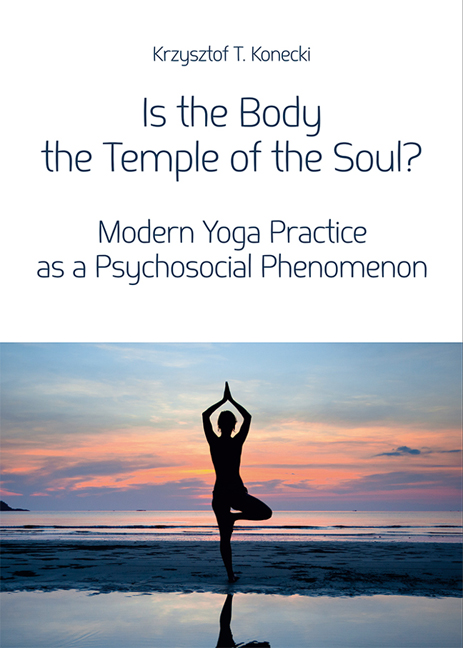Book contents
- Frontmatter
- Contents
- Foreword (Michał Szczepanik)
- Introduction
- Chapter 1 Philosophy and hatha-yoga practice. Para-religious aspects of hatha-yoga
- Chapter 2 The social world of yoga practice
- Chapter 3 Commonsense definitions of yoga and its meaning for practitioners
- Chapter 4 The process of becoming a hatha-yoga practitioner
- Chapter 5 Visual transmission of knowledge and the meaning of corporality and gestures in the social world of yoga practice
- Chapter 6 Emotions and yoga practicing. Working on emotions and achieving “emotional culture” without emotions
- Chapter 7 Teacher and guru in hatha-yoga practice
- Conclusions
- Bibliography
Chapter 4 - The process of becoming a hatha-yoga practitioner
Published online by Cambridge University Press: 10 January 2018
- Frontmatter
- Contents
- Foreword (Michał Szczepanik)
- Introduction
- Chapter 1 Philosophy and hatha-yoga practice. Para-religious aspects of hatha-yoga
- Chapter 2 The social world of yoga practice
- Chapter 3 Commonsense definitions of yoga and its meaning for practitioners
- Chapter 4 The process of becoming a hatha-yoga practitioner
- Chapter 5 Visual transmission of knowledge and the meaning of corporality and gestures in the social world of yoga practice
- Chapter 6 Emotions and yoga practicing. Working on emotions and achieving “emotional culture” without emotions
- Chapter 7 Teacher and guru in hatha-yoga practice
- Conclusions
- Bibliography
Summary
It needs to be remembered that the body is the temple of the soul and it needs to be nourished, cared for as if making the place saintly, then it is in harmony with our mind… Yoga teaches how to love your body, it is a great gift, we got it on the day of birth and it is a great gift and we should take care of it, love it just the way it is.
(from the interview with a yoga instructor)Introduction
This chapter undertakes the problem of perceiving and feeling the body in the process of acquiring the identity of hatha-yoga practitioner. The process of becoming a “yogi” is connected with the practice of work on the body and on defining these practices, engendering a specific perception of the body, and feeling the body.
Becoming a hatha-yoga practitioner is a process. In this chapter I describe the phases of this process: 1) the initial phase – constructing motives and first steps; 2) the phase of a fuller recognition of psycho-physical effects and ascribing appropriate meanings to them; 3) the phase of a fuller recognition of spiritual aspects of hatha-yoga (as a quasi-religion). The relations between the mind and the body become complicated at the moment of meaningful engagement in yoga practice and in defining body practice as mental practice, as well as spiritual. The work on the body can change the Western perspective of defining the body as a material element of human existence (the Cartesian vision), to a vision of treating the body as a spiritualized substance (the vision of Eastern philosophy). Such a change is not always possible if we hold on to the guidelines of other religions as our own (e.g., the Catholic religion). In such a situation, changes in the body and psyche have to be defined differently and also certain language descriptions of these changes have to take place (often acquiring guidelines of set languages formulas) in order to combine the statements of conventional religion with the new spiritual experience.
- Type
- Chapter
- Information
- Is the Body the Temple of the Soul?Modern Yoga Practice as a Psychosocial Phenomenon, pp. 83 - 140Publisher: Jagiellonian University PressPrint publication year: 2016



